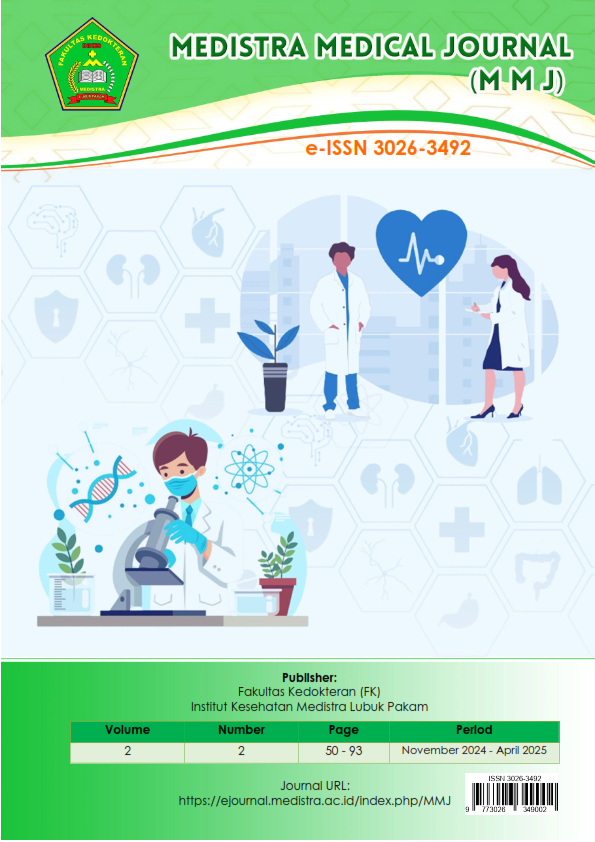The Role of Wearable Technology in Early Detection of Catastrophic Emergencies in Healthcare Services at Patar Asih General Hospital Lubuk Pakam in 2023
DOI:
https://doi.org/10.35451/j17gyz45Keywords:
Wearable; Deteksi Dini; Kegawatdaruratan Katastropik; Rumah Sakit; Teknologi Kesehatan.Abstract
Wearable technology has become an innovation in modern healthcare services, providing real-time monitoring of patients’ vital signs and supporting early detection of catastrophic emergencies. This study aims to analyze the role of wearable technology in early detection of catastrophic emergencies in healthcare services at Patar Asih General Hospital Lubuk Pakam in 2023. A quantitative descriptive research design was employed involving 120 respondents, consisting of healthcare workers and patients who utilized wearable devices. Data were collected through structured questionnaires and observations, then analyzed using descriptive statistics. The results showed that 78.3% of respondents considered wearable devices highly effective in monitoring patients’ vital signs, while 72.5% of healthcare workers reported that these devices facilitated faster responses in emergency conditions. Additionally, 81.7% of respondents agreed that wearable technology increased hospital preparedness in dealing with catastrophic emergencies. However, several obstacles were identified, such as limited device availability, maintenance costs, and the need for training in device utilization. The findings indicate that
References
[1] Albahri, A. S., Zaidan, A. A., Zaidan, B. B., Hashim, M., Albahri, O. S., & Al-Amoodi, A. H. (2021). Wearable sensors for early detection of COVID-19: Review and challenges. Journal of Infection and Public Health, 14(5), 610–620. https://doi.org/10.1016/j.jiph.2021.01.016
[2] Alharbi, F., & Alsubki, N. (2022). Wearable health technologies: Opportunities and challenges in clinical adoption. Journal of Medical Systems, 46(11), 89. https://doi.org/10.1007/s10916-022-01853-y
[3] Alreshidi, M., & Ullah, F. (2020). Applications of wearable technologies in healthcare: A literature review. International Journal of Computer Applications, 975, 8887.
[4] Banos, O., Toth, M. A., Damas, M., Pomares, H., & Rojas, I. (2019). Dealing with the effects of sensor displacement in wearable activity recognition. Sensors, 14(6), 9995–10023. https://doi.org/10.3390/s140609995
[5] BinDhim, N. F., & Trevena, L. (2021). Health-related smartphone apps: Regulations, safety, and quality. JMIR mHealth and uHealth, 9(2), e24778. https://doi.org/10.2196/24778
[6] Chen, M., Ma, Y., Li, Y., Wu, D., Zhang, Y., & Youn, C. H. (2020). Wearable 2.0: Enabling human-cloud integration in next generation healthcare systems. IEEE Communications Magazine, 58(1), 54–61. https://doi.org/10.1109/MCOM.001.1900102
[7] Choi, J., Lee, M., & Lee, J. (2021). The effects of wearable devices on health outcomes: A systematic review. Healthcare Informatics Research, 27(1), 20–34. https://doi.org/10.4258/hir.2021.27.1.20
[8] Chowdhury, M. E. H., Khandakar, A., Alzoubi, K., Mansoor, S., Tahir, A. M., & Reaz, M. B. I. (2019). Wearable real-time heart attack detection and warning system to reduce road accidents. Sensors, 19(12), 2780. https://doi.org/10.3390/s19122780
[9] Dias, D., & Cunha, J. P. (2018). Wearable health devices—Vital sign monitoring, systems and technologies. Sensors, 18(8), 2414. https://doi.org/10.3390/s18082414
[10] Fagherazzi, G., Ravaud, P., & Hernán, M. A. (2020). Digital health strategies to fight pandemics: The COVID-19 case. JMIR Public Health and Surveillance, 6(2), e18996. https://doi.org/10.2196/18996
[11] Guo, Y., Chen, Y., Lane, D. A., Liu, L., Wang, Y., & Lip, G. Y. (2019). Mobile health technology for atrial fibrillation management integrating decision support, education, and patient involvement: mAF-App trial. American Journal of Medicine, 132(11), 1238–1246. https://doi.org/10.1016/j.amjmed.2019.05.009
[12] Guk, K., Han, G., Lim, J., Jeong, K., Kang, T., Lim, E. K., & Jung, J. (2019). Evolution of wearable devices with real-time disease monitoring for personalized healthcare. Nanomaterials, 9(6), 813. https://doi.org/10.3390/nano9060813
[13] Hasan, M. K., Biswas, K., Ahmed, S. I., & Mahmud, M. (2021). IoT-based wearable health monitoring systems: Current progress and future challenges. Journal of Network and Computer Applications, 177, 102936. https://doi.org/10.1016/j.jnca.2020.102936
[14] Heikenfeld, J., Jajack, A., Rogers, J., Gutruf, P., Tian, L., Pan, T., ... & Wang, J. (2019). Wearable sensors: Modalities, challenges, and prospects. Lab on a Chip, 18(2), 217–248. https://doi.org/10.1039/C7LC00914C
[15] Ibrahim, M., & Komatsu, T. (2022). The role of wearable technology in disaster risk management and emergency response. International Journal of Disaster Risk Reduction, 75, 102994. https://doi.org/10.1016/j.ijdrr.2022.102994
[16] Islam, S. R., Kwak, D., Kabir, M. H., Hossain, M., & Kwak, K. S. (2019). The internet of things for health care: A comprehensive survey. IEEE Access, 3, 678–708. https://doi.org/10.1109/ACCESS.2015.2437951
[17] Keshavarz, H., & Sadeghi, R. (2021). The use of wearable technologies in emergency medicine: A scoping review. BMC Emergency Medicine, 21(1), 90. https://doi.org/10.1186/s12873-021-00504-2
[18] Lee, H., Ko, H., & Lee, J. (2020). The future of digital health with wearable technology in healthcare. Journal of Medical Systems, 44(5), 102. https://doi.org/10.1007/s10916-020-01552-5
[19] Li, X., Dunn, J., Salins, D., Zhou, G., Zhou, W., Schüssler-Fiorenza Rose, S. M., ... & Snyder, M. P. (2017). Digital health: Tracking physiomes and activity using wearable biosensors. NPJ Digital Medicine, 1, 3. https://doi.org/10.1038/s41746-017-0003-1
[20] Luo, Y., & Gao, W. (2021). Wearable biosensors for non-invasive health monitoring. Nature Reviews Materials, 6(11), 1174–1187. https://doi.org/10.1038/s41578-021-00332-4
[21] Mishra, T., Wang, M., Metwally, A. A., Bogu, G. K., Brooks, A. W., Bahmani, A., ... & Snyder, M. P. (2020). Early detection of COVID-19 using a smartwatch. Nature Biomedical Engineering, 4(12), 1208–1220. https://doi.org/10.1038/s41551-020-00640-6
[22] Ng, K., Steinhubl, S. R., & de Luca, J. (2020). Wearable technologies for cardiac monitoring in clinical practice. European Heart Journal, 41(7), 139–145. https://doi.org/10.1093/eurheartj/ehz725
[23] Patel, S., Park, H., Bonato, P., Chan, L., & Rodgers, M. (2019). A review of wearable sensors and systems with application in rehabilitation. Journal of NeuroEngineering and Rehabilitation, 9(1), 21. https://doi.org/10.1186/1743-0003-9-21
[24] Piwek, L., Ellis, D. A., Andrews, S., & Joinson, A. (2020). The rise of consumer health wearables: Promises and barriers. PLoS Medicine, 13(2), e1001953. https://doi.org/10.1371/journal.pmed.1001953
[25] Rantanen, A., Parkkari, J., Haapanen, A., & Hämäläinen, P. (2020). Wearable technology in hospital emergency care: A systematic review. Scandinavian Journal of Trauma, Resuscitation and Emergency Medicine, 28(1), 70. https://doi.org/10.1186/s13049-020-00764-4
[26] Satija, U., Ramkumar, B., & Manikandan, M. S. (2020). Real-time signal quality-aware ECG telemetry system for IoT-based health care monitoring. IEEE Internet of Things Journal, 6(3), 880–891. https://doi.org/10.1109/JIOT.2018.2877662
[27] Seshadri, D. R., Li, R. T., Voos, J. E., Rowbottom, J. R., Alfes, C. M., Zorman, C. A., & Drummond, C. K. (2020). Wearable sensors for monitoring the physiological and biochemical profile of the athlete. NPJ Digital Medicine, 2(1), 72. https://doi.org/10.1038/s41746-019-0149-2
[28] Silva, B. M. C., Rodrigues, J. J. P. C., de la Torre Díez, I., López-Coronado, M., & Saleem, K. (2019). Mobile-health: A review of current state in 2015. Journal of Biomedical Informatics, 56, 265–272. https://doi.org/10.1016/j.jbi.2015.06.003
[29] Wang, L., & Wong, A. (2020). COVID-19 and the acceleration of digital health: Advancing the wearable health revolution. Frontiers in Medicine, 7, 606. https://doi.org/10.3389/fmed.2020.00606
[30] WHO. (2021). Digital health interventions for health system strengthening. World Health Organization. https://apps.who.int/iris/handle/10665/344249
Downloads
Published
Issue
Section
License
Copyright (c) 2025 Elaninanivi Br Tarigan

This work is licensed under a Creative Commons Attribution 4.0 International License.
Copyright in each article is the property of the Author.
















